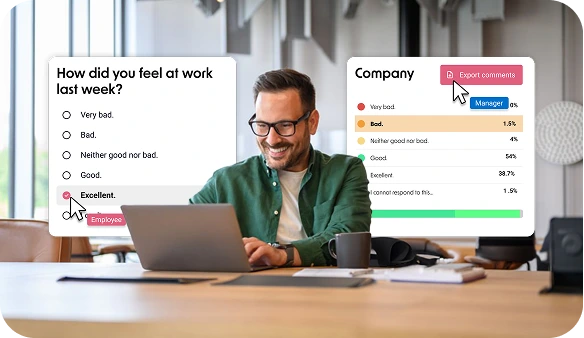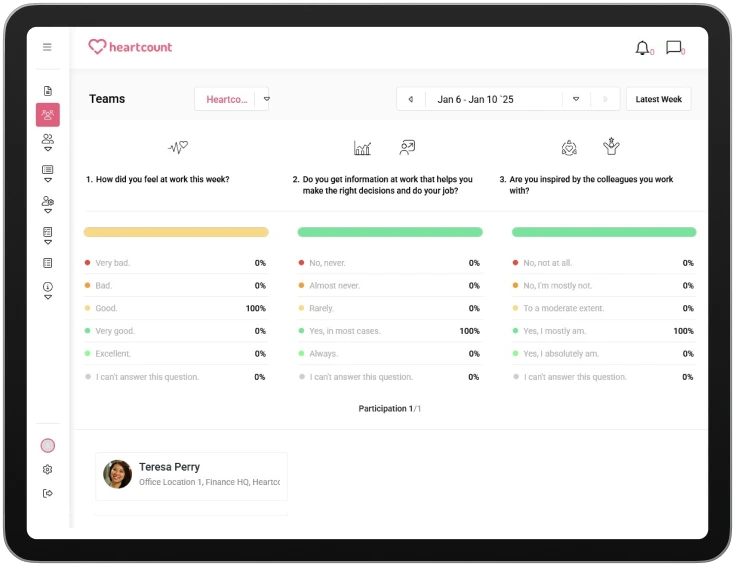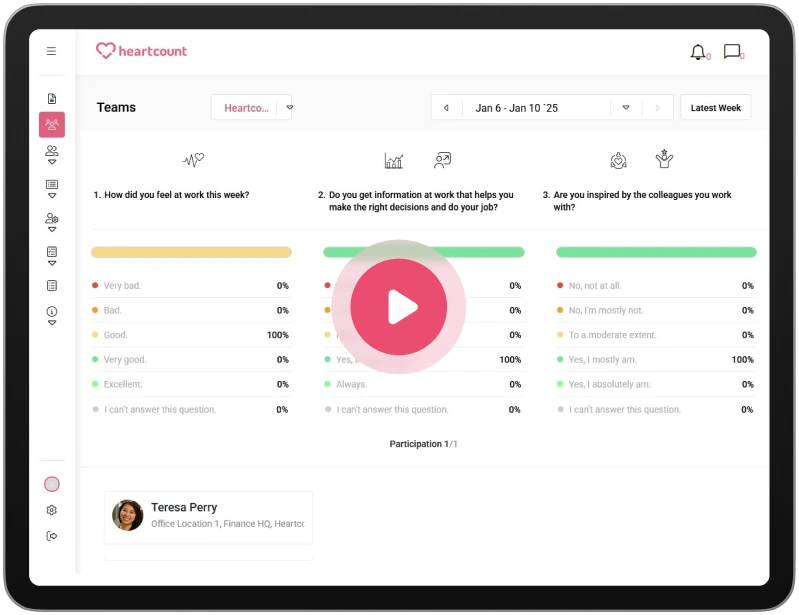Stay Interviews: Definition, 25 Best Questions & Proven Steps to Boost Retention

In today’s competitive job market, retaining great people is just as important as hiring them. But too often, organisations wait until an employee hands in their notice to ask the most important questions—why are you leaving, and what could we have done differently?
That’s where stay interviews come in. These simple, intentional conversations help leaders uncover what keeps employees engaged, what might drive them away, and how to make their day-to-day experience better—before it’s too late.
Unlike exit interviews or annual surveys, stay interviews are real-time, person-to-person check-ins that build trust and surface actionable insight. When done right, they become a cornerstone of a strong retention strategy and a more human workplace culture.
In this guide, we’ll break down exactly what a stay interview is, why it matters in 2025’s evolving workforce, and how to run one effectively. You’ll also find 25 ready-to-use questions, practical best practices, and a step-by-step playbook for putting it into action—backed by expert insights and tools from HeartCount.
Let’s start with the basics: what exactly is a stay interview, and how is it different from other types of employee feedback?
-
1.What Is a Stay Interview?
-
2.Why Conduct Stay Interviews?
-
3.When and Who: Stay-Interview Logistics
-
4.How to Conduct a Stay Interview (Step-by-Step)
-
5.Top 25 Stay-Interview Questions (With Intent Tags)
-
6.Stay Interview Best Practices
-
7.Closing the Loop: Turning Feedback Into Action
-
8.FAQ: Stay Interviews Explained
In today’s competitive job market, retaining great people is just as important as hiring them. But too often, organisations wait until an employee hands in their notice to ask the most important questions—why are you leaving, and what could we have done differently?
That’s where stay interviews come in. These simple, intentional conversations help leaders uncover what keeps employees engaged, what might drive them away, and how to make their day-to-day experience better—before it’s too late.
Unlike exit interviews or annual surveys, stay interviews are real-time, person-to-person check-ins that build trust and surface actionable insight. When done right, they become a cornerstone of a strong retention strategy and a more human workplace culture.
In this guide, we’ll break down exactly what a stay interview is, why it matters in 2025’s evolving workforce, and how to run one effectively. You’ll also find 25 ready-to-use questions, practical best practices, and a step-by-step playbook for putting it into action—backed by expert insights and tools from HeartCount.
Let’s start with the basics: what exactly is a stay interview, and how is it different from other types of employee feedback?
What Is a Stay Interview?
A stay interview is one of the simplest yet most powerful tools for boosting employee retention. Unlike exit interviews, which reveal why someone has already decided to leave, stay interviews focus on understanding why people choose to stay—and what might make them reconsider.
These conversations are typically one-on-one meetings between a manager and an employee, aimed at uncovering what motivates, frustrates, or inspires that person at work. They offer an opportunity to strengthen relationships, surface concerns early, and act on what matters most to your team.
Stay interviews aren’t about performance evaluation or engagement scoring—they’re about listening. When done well, they help create a culture where employees feel seen, valued, and heard before problems become reasons to leave.
Benefits of Stay Interviews
Stay interviews deliver several key benefits for organisations and employees alike. They:
- Reduce turnover by proactively addressing concerns
- Strengthen trust and communication between managers and their teams
- Help identify development opportunities and career aspirations
- Surface early warning signs of disengagement or burnout
- Empower employees to feel valued and heard
What Are the Main Goals of Stay Interviews?
While every conversation will be unique, most stay interviews aim to achieve four core goals:
- Understand why employees choose to stay with the organisation
- Discover what might prompt them to leave in the future
- Identify improvements that could increase their engagement and satisfaction
- Build a stronger, trust-based relationship between the employee and their manager
Stay Interview Meaning vs. Exit Interview vs. Pulse Survey vs. Performance Review
To understand the true value of a stay interview, it helps to contrast it with other common employee feedback tools—specifically, exit interviews, pulse surveys, and performance reviews.
- Exit interviews are conducted after an employee has already decided to leave. While they can offer useful feedback, they often come too late to influence the outcome. Employees may also be less honest or emotionally disengaged by that point, making the data less actionable.
- Pulse surveys, on the other hand, are short, frequent questionnaires designed to track engagement trends over time. Tools like HeartCount’s automated pulse check surveys offer scalable insights across teams and departments, helping leaders spot shifts in sentiment early.
- Performance reviews are typically scheduled evaluations that assess an employee’s contributions, strengths, and development areas over a set period. Although they can include elements of feedback and career planning, they are often focused more on past performance and goal setting than on proactively understanding what keeps employees committed.
- A stay interview fills the middle ground: it’s a real-time, personal dialogue focused on why an employee continues to work for the organisation, what could make them leave, and how their experience can be improved now—not after they’ve already made a decision.
Think of pulse surveys as signals, exit interviews as post-mortems, performance reviews as structured appraisals, and stay interviews as preventive care—a timely way to reduce turnover risk and strengthen team trust.
Why Stay Conversations Matter in 2025’s Talent Market
In today’s workforce landscape, retention isn’t just an HR metric—it’s a strategic priority. A Gallup study found that 52% of exiting employees say their manager could have done something to prevent them from leaving—but no one ever asked. This is exactly where stay conversations come in.
As flexibility, belonging, and growth increasingly shape employee decisions, stay interviews help leaders:
- Understand what’s working at the team level
- Identify high performers at risk
- Uncover blockers to engagement before they escalate
In a time where replacing an employee can cost up to 50–200% of their annual salary, implementing consistent stay interviews is one of the most cost-effective retention strategies available.
Why Conduct Stay Interviews?
In a world where employee turnover is more expensive—and preventable—than ever, stay interviews offer a direct path to understanding and retaining your best talent. They help uncover the emotional drivers behind commitment, give managers insight into what motivates their teams, and build the foundation for proactive, human-centred leadership.
Instead of relying solely on anonymous surveys or late-stage feedback from departing employees, stay interviews enable honest, two-way conversations while people are still present and invested. For HR teams and managers, that insight is gold.
Let’s explore the business case behind this approach—why it matters, and how it delivers measurable ROI.
Retention ROI: Cost of Losing Engaged Employees
Replacing an employee isn’t just a hassle—it’s a major cost. Research by Gallup estimates that voluntary turnover costs U.S. businesses over $1 trillion annually. On an individual level, the cost of replacing a single employee ranges from 50% to 200% of their annual salary, depending on the role and seniority.
But the true cost goes deeper: lost institutional knowledge, disrupted teams, and reduced morale across the board.
Stay interviews are a low-cost, high-impact strategy that targets retention at its core. Rather than retroactively analysing why someone left, they intercept disengagement early, when meaningful action can still make a difference. When paired with tools like HeartCount’s employee experience platform, companies can move from reactive to proactive—saving both money and morale.
Early Insights You Won’t Get from Exit Surveys
Exit surveys often surface issues that have been simmering for months—communication breakdowns, lack of growth, or management challenges. But by the time those insights emerge, the damage is done.
Stay interviews flip that timeline. They allow managers to ask:
- “What’s making you want to stay?”
- “What’s making work harder than it needs to be?”
- “What would make your experience better right now?”
These questions open up real-time feedback, which companies can act on immediately—without the filter of frustration or finality. And when combined with data from employee satisfaction surveys or feedback loops, they offer a more complete picture of both individual sentiment and organisational patterns.
HeartCount Pulse Data: Pinpoint Who to Interview First
One of the most overlooked aspects of conducting stay interviews is knowing who to start with. Not every employee needs a one-on-one immediately—but the ones who do can be identified through pulse data signals.
HeartCount’s automated employee pulse check surveys help HR teams and managers spot patterns like declining motivation, disengagement, or reduced peer recognition. These indicators can guide which employees to prioritise for stay interviews—before disengagement turns into attrition.
When pulse data is integrated with stay interviews, it becomes a closed-loop system for engagement: diagnose → discuss → act → track.
COLLECT
When and Who: Stay-Interview Logistics
Stay interviews are powerful—but only when they’re done intentionally. That means choosing the right moment, the right people, and the right setting. Rushing the process, assigning the wrong interviewer, or springing the conversation unexpectedly can all reduce the effectiveness of what should be a trust-building experience.
This section breaks down the timing, ownership, and format that make stay interviews work in real teams.
Ideal Cadence by Tenure & Performance Tier
There’s no one-size-fits-all schedule, but cadence matters. High performers and employees in critical roles should be prioritised for more frequent check-ins. A general guideline looks like this:
- New employees (first 3–6 months): 1 stay conversation after onboarding
- Tenured team members (6–24 months): Every 6–12 months
- High-potential or at-risk employees: Quarterly or even monthly if pulse data suggests emerging issues
This cadence helps managers build trust gradually, while still staying ahead of potential disengagement. It also reinforces a message that the company doesn’t just value feedback—but acts on it regularly.
Who Should Conduct the Interview? Manager vs. HR
In most cases, the direct line manager is the ideal person to conduct a stay interview. They have the closest relationship with the employee, the best context for their work, and the most immediate ability to act on feedback.
However, there are situations where HR or People Ops may step in:
- The manager-employee relationship is strained
- Sensitive topics are expected
- There’s a need for more anonymity or neutrality
Regardless of who leads, the interviewer must be trained in active listening, empathy, and follow-through. Stay interviews can do more harm than good if they’re treated like a formality or interrogation.
Virtual vs. In-Person: Choosing the Right Setting
In today’s hybrid world, flexibility in format is essential. Whether the interview is virtual or in-person, the goal is the same: create a safe, private space for honest dialogue.
Best practices for both:
- In-person: Choose a neutral, quiet room (not across a desk), allow for informal tone
- Virtual: Use video if possible, avoid multitasking, and reinforce psychological safety upfront
More important than the format is the intentionality. Give employees notice, explain the purpose, and ensure they feel the conversation is for their benefit—not a performance review in disguise.
For remote teams, pairing virtual stay interviews with transparent feedback practices—like those outlined in HeartCount’s workplace transparency guide—can help bridge the distance and build connection.
How to Conduct a Stay Interview (Step-by-Step)
A successful stay interview isn’t about checking off questions—it’s about building trust and gathering insight that leads to action. This section walks through a step-by-step approach that ensures every conversation is thoughtful, meaningful, and impactful.
Prep: Analyze Signals & Draft Tailored Questions
Before the conversation starts, preparation is key. Use available insights—like recent team changes, manager check-ins, or shifting morale—to identify themes worth exploring.
Then, tailor your questions. While it’s helpful to have a standard question library, avoid sounding scripted. Focus on:
- Work satisfaction
- Growth opportunities
- Team dynamics
- Feedback and recognition
- Future intentions
Reviewing employee satisfaction survey responses can also help frame the conversation around topics that already matter to your team.
Conversation Flow: Opening, Core, Closing
Structure matters, especially for employees unfamiliar with stay interviews. Use a clear, three-part flow:
- Opening: Set expectations. Reassure them this is not a performance review, but a chance to understand how things are going from their perspective.
- Core: Ask 4–6 open-ended questions. Listen actively, reflect, and follow up on anything that feels emotionally charged or unexpected.
- Closing: Recap key themes. Ask if there’s anything they didn’t get to share. End by thanking them and explaining what will happen next.
Keep the tone relaxed, conversational, and curious—this isn’t an interrogation, it’s a check-in.
Documenting Insights the Right Way
Documentation is critical—but it must be done with care. Don’t transcribe word-for-word or log personal frustrations without context. Instead, summarise key insights into themes like:
- Drivers of motivation
- Friction points or concerns
- Suggested improvements
- Retention signals
Where appropriate, anonymised patterns can be shared with HR or leadership to shape broader engagement strategies.
Use internal tools or shared platforms to track these themes over time and ensure continuity in future check-ins.
Post-Interview: Share Themes & Commit to Action
The interview isn’t over when the conversation ends. The most important part comes next: taking action.
- Share high-level themes with the employee: “Here’s what I heard, and here’s what I’ll follow up on.”
- Assign clear owners and next steps (e.g. raise with HR, adjust workflows, recognise achievements).
- Set a timeline to revisit. Even a 15-minute check-in 30 days later can reinforce trust and momentum.
And most importantly, follow through. Employees are quick to notice when feedback goes nowhere. That’s why a strong feedback culture is essential—not just during interviews, but in daily interactions.
When stay interviews lead to meaningful action, they become more than a one-time meeting. They become a retention engine.
Top 25 Stay-Interview Questions (With Intent Tags)
The strength of a stay interview lies in the quality of the questions asked. A well-crafted question can uncover what’s working, what’s missing, and what might cause someone to leave—even if they’ve never said it out loud.
Below are 25 proven stay interview questions, grouped by intent. Each one is designed to spark reflection and uncover key engagement drivers like growth, recognition, leadership, flexibility, and long-term commitment.
Growth & Development
“Which new skills would you like to learn this year?”
→ Signals ambition, unmet learning needs, or areas where L&D can better support them.
“Is there a project or responsibility you’d like to take on that you haven’t yet?”
→ Surfaces internal blockers, untapped strengths, and succession planning potential.
“Do you feel your career is progressing here?”
→ Explores alignment with long-term goals and perceived opportunity.
“What part of your role do you wish you could spend more time on?”
→ Identifies energisers vs. drainers in day-to-day work.
“Where do you see yourself in the next 12–18 months?”
→ Opens the door to internal mobility conversations.
Recognition & Purpose
“What recent win made you feel proud?”
→ Highlights what the employee values and how they define success.
“Do you feel your work is recognised often enough?”
→ Checks in on reward systems and cultural appreciation.
“What kind of recognition feels most meaningful to you?”
→ Useful for personalising employee recognition practices.
“How connected do you feel to the company’s mission or purpose?”
→ Reveals alignment with culture and whether the employee feels they’re part of something bigger.
“When was the last time you felt your work really mattered?”
→ A subtle but powerful way to gauge purpose-driven engagement.
Leadership & Culture
“How supported do you feel by your manager?”
→ One of the strongest predictors of retention; opens the door to improvement.
“Do you feel like your ideas and feedback are taken seriously?”
→ Explores psychological safety and empowerment.
“What’s one thing we could change to make the team experience better?”
→ Low-pressure prompt to uncover team dynamics issues.
“Do you feel like you belong here?”
→ A direct question for inclusion and cultural fit.
“How would you describe our team culture in one word?”
→ Quick gut-check that often reveals surprising insights.
Flexibility & Well-Being
“What helps you maintain balance during busy periods?”
→ Spotlights resilience tools, coping mechanisms, or unmet needs.
“Do you feel your current workload is manageable?”
→ A soft entry into burnout risks.
“How do you like to disconnect or recharge?”
→ Helps tailor benefits or work style support to individual needs.
“Have you felt pressure to always be ‘on’?”
→ Flags presenteeism or overworking culture.
“What could we do to better support your well-being?”
→ Encourages creative and practical suggestions.
Future & Commitment
“What might tempt you to consider other roles?”
→ This is key. If asked with care, it surfaces risks before they become decisions.
“Have you ever thought about leaving? If so, why?”
→ Allows for honesty without pressure or consequence.
“What’s keeping you here right now?”
→ Reinforces strengths—and reveals what to protect.
“What would make you more likely to stay long-term?”
→ Offers a platform for retention suggestions from the source.
“If you could change one thing about your job, what would it be?”
→ Simple but powerful. Often, the answer is surprisingly fixable.
UNDERSTAND
Stay Interview Best Practices
Stay interviews can unlock invaluable insight—but only if they’re done thoughtfully. Without the right conditions, these conversations can feel performative or even uncomfortable. To truly support retention and engagement, they need to be rooted in trust, consistency, and psychological safety.
Below are key best practices that help managers and HR teams turn stay interviews into a meaningful part of the employee experience.
Prioritise Two-Way Listening & Psychological Safety
A stay interview should never feel like a test. It’s not about performance or compliance—it’s about understanding.
That means giving the employee space to speak freely, without fear of judgment or retaliation. Use open body language, avoid interrupting, and take pauses before responding. Some of the most valuable insights surface only when the employee realises you’re really listening.
If psychological safety is lacking, feedback won’t be honest—and the opportunity is lost.
Schedule, Don’t Surprise: Give Context Up Front
No one likes to be pulled into a meeting with no idea why. Let employees know in advance that this is a stay conversation, not a performance check or disciplinary chat. Share what to expect, how long it will take, and why their input matters.
Framing matters—especially in workplaces where trust is still being built.
Leave Ample Pause Time – Silence Yields Insight
Avoid the instinct to fill every silence. A few seconds of quiet often gives the employee time to reflect more deeply—and say what they truly think.
If a question doesn’t land immediately, don’t move on. Let it breathe. Some of the most honest answers come after the hesitation.
Common Mistakes to Avoid (Interrogation Tone, No Follow-Up)
Even with the best intentions, stay interviews can backfire if mishandled. Common pitfalls include:
- Asking too many questions back-to-back without reflection
- Taking a defensive stance when criticism arises
- Treating the session as a one-off exercise
- Failing to follow up on feedback
These behaviours erode trust and send the message that feedback doesn’t really matter.
For stay interviews to drive change, they must be part of a broader engagement strategy—one that includes listening, responding, and improving continuously. For more on building that kind of workplace culture, see how to drive employee engagement.
Closing the Loop: Turning Feedback Into Action
A stay interview without follow-up is worse than no interview at all. When employees open up and nothing changes, trust erodes quickly—and so does retention. That’s why closing the loop is the most critical part of the stay interview process.
Turning insights into action isn’t about grand gestures. It’s about creating visible, trackable momentum—showing employees their voices lead to meaningful outcomes.
HeartCount Action Loop: Listen → Diagnose → Act → Track
One way to embed follow-through is by adopting a simple feedback loop framework:
- Listen – Create space for honest feedback during the stay interview
- Diagnose – Identify patterns across individuals or teams
- Act – Implement one or two clear changes (don’t overpromise)
- Track – Revisit the topic, measure progress, and adjust as needed
This cycle doesn’t require massive resources—it requires consistency. When employees see that sharing leads to action, engagement naturally grows.
Assign Owners & Deadlines for Each Commitment
Good intentions aren’t enough. After a stay interview, it should be crystal clear:
- What’s being done in response
- Who’s responsible for making it happen
- When it will be followed up
Even small changes—like adjusting meeting formats or acknowledging wins—can build credibility when they’re tied to clear ownership.
Use shared documentation, Slack reminders, or existing HR tools to keep these commitments visible and accountable.
Use Check-Ins to Monitor Progress Post-Interview
Don’t let stay interviews be a once-a-year ritual. Follow up 2–4 weeks later with a short check-in:
- “We talked about this—has anything improved?”
- “Is this still a pain point?”
- “Have you noticed any changes?”
This helps you recalibrate quickly and reinforces a culture of continuous improvement.
Together with other feedback practices—like two-way feedback loops and team-driven engagement initiatives—stay interviews become a central piece of a human-first retention strategy.
ACT
FAQ: Stay Interviews Explained
What is a stay interview?
A stay interview is a one-on-one conversation where a manager asks an employee why they stay in their role and what might cause them to leave. It’s used to build trust and identify ways to improve retention.
How do you conduct a stay interview?
You conduct a stay interview by setting up a dedicated, informal meeting, asking open-ended questions, actively listening, and following up with clear actions based on what was shared.
What are the differences between stay interviews and performance reviews?
Stay interviews are forward-looking conversations focused on understanding why employees stay, what could make them leave, and how their experience can be improved right now. Performance reviews, on the other hand, evaluate past achievements, skills, and goal progress, usually linked to compensation or promotion decisions. While performance reviews are often more formal and structured, stay interviews are conversational and centred on engagement and retention.
What is the difference between a stay interview and an exit interview?
A stay interview happens while an employee is still committed to the organisation, aiming to proactively address any issues before they lead to turnover. Exit interviews occur after an employee has decided to leave, providing retrospective insights into why they resigned. In other words, stay interviews help prevent exits, while exit interviews help you learn from them.
What are the best stay-interview questions?
The best questions explore engagement drivers like growth, recognition, leadership, and well-being. Open-ended prompts such as “What keeps you here?” or “What might make you leave?” work well.
How often should stay interviews be done?
They should be done once after onboarding, then every 6 to 12 months. High-potential or at-risk employees may benefit from more frequent check-ins.
Who should receive stay interviews first?
Start with your top performers or employees in key roles who show signs of disengagement. These conversations can prevent early turnover and surface valuable feedback.
Are stay interviews effective for remote teams?
Yes, stay interviews work well remotely if you set clear expectations, use video when possible, and follow up consistently to show that feedback is taken seriously.











